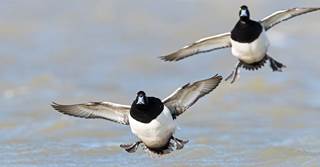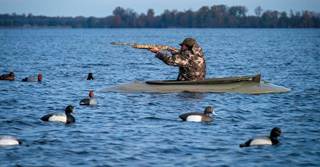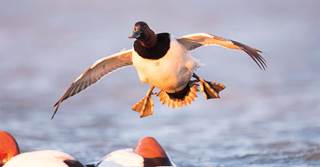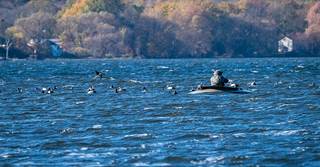Divers the Hard Way
Hunting big water from a layout boat is specialized, difficult, and even a little dangerous. But if you like to decoy bluebills, redheads, and canvasbacks in close, nothing else compares
Hunting big water from a layout boat is specialized, difficult, and even a little dangerous. But if you like to decoy bluebills, redheads, and canvasbacks in close, nothing else compares

By Will Brantley
We nearly sank it the first time we took it out. My buddy Tim had found the one-person layout boat for sale online, and we bought it, certain it was the cure for all our bluebill-hunting woes. We embarked on our maiden voyage shortly after sunrise on a cold January day, towing the layout boat behind my 16-foot War Eagle. Our plan was to set up in a secondary channel between a pair of islands. Bluebills flew that stretch of water like a busy highway. We'd watched them for years and had set up on the islands plenty of times, trying to pull stragglers off their flight paths without much luck.
That day, we thought, our fortunes would change. The outboard started quickly and we were on our way, feeling almost smug about what was in store. We probably shouldn't have been so cocky, though, considering we had no experience whatsoever with this type of waterfowling. We started out a little too fast, inundating the layout boat's cockpit with several gallons of green Tennessee River water. Fortunately, we were over a sandbar where it was shallow enough to wade, and we'd had the foresight to bring along a bailing bucket.

Photo DAVIDSTIMAC.COM
An hour later, we had the layout boat anchored upwind of three dozen bluebill decoys bobbing in a light chop. I climbed in, and Tim handed me my shotgun before motoring away in the big boat to watch from afar. There's not much to listen to in a layout boat except for the waves lapping against the fiberglass hull. You're alone with your thoughts, the prevailing one being that the odds of a cold and miserable death suddenly seem much greater than they were a short while ago. Suddenly, I was jarred by what sounded like ripping duct tapethe telltale rush of frigid air being cut by slashing wingsas a knot of 10 bluebills roared right overhead, banking hard into the wind with their webbed feet down.
I appreciate diving duck feet. The birds swing them like rudders on final approach, and if you can see them, it's a sure sign that it's time to shoot. The flock came in so fast and so close that I panicked and emptied my gun in the general direction of the flock as it roared past the boat. I didn't pull a feather. The entire encounter, from the sound of the ripping tape to the bolt of my empty gun locking open, was over in a matter of seconds. Compared to the pace of a dabbling duck hunt, gunning big-water divers is like watching a video on fast-forward.
I looked around, waiting for Tim to give me hell, but he was hundreds of yards away in the tender boat. Somehow, the silence made it worse. So the light splash that I heard beside the boat was almost deafening. I looked up to see ripples settling from a drake bufflehead that had come flitting into the decoys. He sat there as I reloaded and flushed as I sat up to shoot. This time, I made the shot and flagged down Tim to come retrieve our first duck taken from the layout boat. I had learned an important lesson about this unique style of hunting: You've got to slow down, not only to make your shots, but also to really appreciate what you're doing out there.

Photo Brandon Macdonald
Greg Bires says our layout boat was simply called "The Classic." During the 1990s, Bires and fellow diving duck hunting enthusiast Mark Rongers built a small business specializing in the production of traditional Great Lakes layout boats and hunting accessories. They called their northern Indiana-based company, partially in jest, the Mighty Layout Boys.
"We started the business because we wanted to be more successful at something we had a passion for doing," Bires says. "The boats that we used back in the '70s and '80s had problems, the biggest being that they were just too heavy. You had to tow them, and getting from point A to point B took a long time, because you couldn't pull them fast enough."
The first layout boat the company produced was the single-person Classic. It weighed less than 90 pounds and was Coast Guard certified. The boat was safe, stable, and light enough to be carried on a larger tender boat to the hunting area. All told, Mighty Layout Boys manufactured hundreds of boats in its heyday, but the company was eventually sold, and Bires isn't sure the Classic is even being made anymore. Still, the boats are tough, and it's a good bet that most of the originals are still in service. Bires still hunts from his.
"The whole layout experience is different from what most duck hunters are used to," Bires says. "To do it properly and have the full experience, you have to hunt big water. These days, lots of low-profile boats are called layouts. But most of them wouldn't be safe in 20 feet of water with two-foot rollers. In a true layout boat, your feet are down below the waterline. You're watching the ducks come from 200 to 300 yards out, right on the deck. You'll be aiming at a bird, and then he'll disappear behind a wave. There's just nothing like it."
Besides the adrenaline rush, layout hunting just works. It's not my first approach for puddle ducks, which tend to circle at higher altitudes and spot you in the boat. But for diverswhich learn to avoid danger simply by staying away from the shorelineit's kryptonite. Sea ducks, bluebills, redheads, canvasbacks, goldeneyes, and buffleheads often finish so well to an open-water layout spread that they almost seem reluctant to flare when you sit up to shoot.

Photo DAVIDSTIMAC.COM
Layout hunting opens new opportunities, too, since most major lakes and rivers are open to public hunting, but not always from the shoreline. I always felt confined, stuck in a permanent blind on a big lake, and I longed to be out there on the big water where the birds were moving. Layout boats allow you to do just that, and in most places, you won't face any competition.
Of course, layout hunting has its downsides, the biggest being that it's a hell of a production and hassle and pretty much impossible to do alone. "It's a tremendous amount of effort," Bires says. "Not many hunters have the gearor want to do the work requiredto hunt like this." In addition to a layout boat and a safe system for anchoring it (we use dual boat anchors; one on each end of the boat), you need at least one hunting partner to operate the tender boat, which must be big and seaworthy enough to tow or carry the layout and other gear in rough water. My own 16' by 48" modified V-hull War Eagle, which is powered by a 40-horsepower outboard, is about the minimum equipment for the job. There's just enough room to ratchet-strap the layout to the bow (we've learned to do that instead of towing it), pile in the decoys, and transport two hunters. But it's tight.
"Layout hunting is dangerous," Bires admits. "Things can go wrong, fast. All of a sudden you wrap a decoy line around the boat prop, and you're adrift in open water, leaning over the outboard, trying to untangle it. You don't want things like that to happen, but if you're doing this with any amount of regularity, they will."
As such, layout hunters must come prepared. In my boat, we keep sharp pocketknives handy, plus extra props and shear pins for the outboard and the tools to change them. I bring along a trolling motor and a fully charged battery. We wear inflatable PFDs and keep a change of clothesplus fire-starting equipmentin a dry bag secured in the boat. A GPS allows us to locate shallow shoals and other prime hunting areas safely in the dark. Cell phones can be hard to handle in a layout boat, so a good handheld radio is the best way to communicate with the tender boat.

Photo Brandon Macdonald
Shooting diving ducks from a layout boat isn't as simple as tossing out some decoys, anchoring the boat, and hoping for the best. There's a lot of nothing out there on the big water, so scouting is every bit as important as it is in other forms of waterfowling. Underwater shoals and mussel beds are impossible to see with the naked eye, but chart-plotters and bottom contour maps make it easy to find areas where the water depth and terrain are favorable. From there, it's simply a matter of putting eyes on your quarry.
"It's just like anything else; you drive and glass to find where they're feeding," Bires says. "We also pay attention to the flight paths the birds use and the different areas where they raft up during the day. On larger bodies of water, the birds have a lot of options, but over time, you'll discover that they use the same places, season after season."
On the Great Lakes, redheads and bluebills are the predominant species, but Bires frequently takes canvasbacks as well. "We set our decoys on long lines and mix different species together so it looks like a mass of actively feeding birds. We used to keep the lines on a reel, and we'd clip the decoys onto swivels on the line as we unwound it," he says. "But that takes a team of guys who can work together and know what they're doing. Lately, we've been using lines with decoys already clipped on them, stored in barrels. We drop the weight first, and then let the wind push us and unwind the lines."
Setting long lines in open water takes practice, however you do it. Tim and I still use reels for our decoy lines, and I run the trolling motor and work the reel as Tim sits in the stern and clips decoys onto the line, one at a time. As long as you can deploy decoys without getting the line tangled, there's not a wrong way to do it.
As for spread size, the bigger the better on open water, but you can get by with fewer decoys in a good spot. "Back in the day, if we didn't put out 12 or 13 dozen decoys, it seemed inadequate," Bires says. "But now I'm running just three or four long lines, with another two to three dozen individually rigged decoys mixed in. It seems to work well."
It's fascinating to see it all come together. Soon after my disastrous performance on the first flock of bills during our maiden layout hunt, I watched a single drake scaup take notice of our spread. He was coming straight up the channel from downwind as if he was late for an important meeting. He began setting his wings 70 yards out, flapping and then cupping to stabilize himself. At 40 yards he was locked, and I saw his big feet go down. I sat up slowly, focused right on his blue bill, and shouldered my gun. I took my time, and the shot was almost too easy. I bagged a second drake a few minutes later to fill my limit. I held up the white flag we'd brought along just for this moment, signaling that it was Tim's turn in the layout.
As I traded places with Tim and tossed him an extra box of shells, I knew I'd been bitten by something contagious, figuratively anyway, out there on the big water. To this day, I haven't been cured of it.
Venturing out on the big water when it's cold, windy, and dark is not for the faint of heart. Experienced diver hunters realize the dangers inherent in their sport, and they always head out with the tools and equipment they might need to deal with emergencies. These include cell phones and walkie-talkies, pocketknives, extra props and shear pins, assorted tools, and PFDs. It's also a good idea to pack fire-starting equipment, gloves, and a change of clothing in a dry bag.
Ducks Unlimited uses cookies to enhance your browsing experience, optimize site functionality, analyze traffic, and deliver personalized advertising through third parties. By continuing to use this site, you agree to our use of cookies. View Privacy Policy